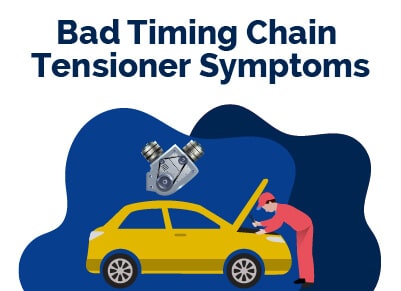Top 5 Symptoms of a Bad Timing Chain Tensioner
February 26, 2024


I am a serial entrepreneur and a consumer advocate. When I’m not helping car buyers, I love working on ventures that have a positive impact.
I run a cause marketing agency and serve on the board of Vayu Global Health where we are disrupting the medical industry and preventing the needless deaths of mothers and babies during childbirth.
The timing chain is located at the front of the engine, just under a small access plug.
It helps maintain the proper tension between the various parts of your vehicle's system. It can prevent failure and improve the efficiency of your water pump and alternator.
Unfortunately, a faulty one can lead to various mechanical issues, which is why you must know the top symptoms of a bad timing chain tensioner.
Let’s dive into the most common symptoms of a bad timing chain tensioner, what causes it to fail, and how to prevent a faulty timing chain tensioner.
Key Takeaways
- The timing chain tensioner keeps the correct tension on your timing chain, ensuring it runs properly.
- The top symptoms of a bad timing chain tensioner include poor engine performance, check-engine light illuminated, and engine rattling noises.
- The most common cause of tensioner problems is lack of maintenance, especially oil changes.
Table of Contents
- Key Takeaways
- Timing Chain Tensioner Symptoms Video
- What Does a Timing Chain Tensioner Do?
- What Causes a Timing Chain Tensioner To Go Bad?
- Symptoms of Bad Timing Chain Tensioner
- How Long Does the Timing Chain Tensioner Last?
- How To Prevent Timing Chain Tensioners from Going Bad
- How Do You Inspect the Timing Chain Tensioner?
- Conclusion
- Best Car Deals by Category
- Frequently Asked Questions
Timing Chain Tensioner Symptoms Video
What Does a Timing Chain Tensioner Do?
There are two types of timing chain tensioners: mechanical chain tensioners and hydraulic tensioners.
The primary function of the timing chain tensioner is to:
- Apply tension to the timing chain to ensure proper engine performance: A timing chain tensioner ensures that the correct tension is applied to the various parts of the timing chain, such as the camshaft sprocket and the crankshaft sprocket. By applying the correct tension, it ensures that the chain runs smoothly and prevents it from coming off the sprockets.
- Protect the alternators and water pumps: It also helps protect other components such as water pumps and alternators from failure.
- Absorb shock and vibration: The chain can absorb shock and vibration as it's driven, which helps improve its resistance to wear.
The tensioner is an integral part of the entire timing chain system.
What Causes a Timing Chain Tensioner To Go Bad?
There are a few common reasons why the timing chain tensioner may fail including:
- Lack of Maintenance: The most common cause of a bad timing chain tensioner is failure to properly carry out scheduled car maintenance, especially oil changes.
- Wear and Tear on Older Vehicles: Also, wear and tear as a result of age may also lead to this problem.
- Timing Chain Over-Extension: Another leading cause of bad timing chain tensioner is the over-extension of the timing chain.
Symptoms of Bad Timing Chain Tensioner
The timing chain tensioner doesn't go bad suddenly. Instead, it is a gradual process that happens over time.
Fortunately, this means you can identify symptoms that it’s going bad and change it before that happens.
However, ignoring these symptoms can lead to considerable damage to the vehicle's engine.
The symptoms of a bad timing chain tensioner include the following;
1. A Noisy Engine
The unusual noise emanating from the engine may signal a failing timing chain tensioner. While you’re driving, it may sound like a knocking or a buzzing sound.
When the chain goes loose, it eventually starts hitting other parts of the vehicle's engine.
2. Check Engine Light
The check engine light will only come on when something is wrong with the engine.
It could be anything from a faulty timing chain tensioner to any other thing in the engine.
The chain often appears loose in the connected parts of the chain when the timing chain tensioner gets bad.
The failure of the timing chain can cause the engine to malfunction and even prevent it from running.
In extreme cases, the car would not be able to start, because a bad timing chain can cause the valve to move beyond its limit.
You must conduct a further diagnosis with an engine scan tool to determine if the issue is related to the faulty timing chain tensioner.
3. Engine Misfire
A misfire occurs when the engine cannot start because there is no combustion of the air and fuel mixture within the cylinder.
Some possible reasons this issue can occur are a faulty ignition coil, a leaky intake manifold, low fuel pressure, defective spark plugs, and, of course, a faulty timing chain tensioner.
For instance, if the valve moves at a time that doesn't coincide with the piston's rise and fall, it prevents the combustion of the air and fuel mixture within the cylinder. This could also affect the ratio of the air-fuel mixture.
If this issue persists, the engine might not be able to deliver the boost that it needs to maintain its performance.
4. Engine Failure
If you ignore the warning signs of a faulty timing chain tensioner, you might end up with a total engine failure.
In addition to the cost of replacing the chain, you might also be dealing with other issues related to the car's engine.
The movement of the cylinder's components, such as the crankshaft and camshaft, can get disturbed and prevent the valves from closing properly. This issue can then cause the engine to fail.
5. Difficulties Starting the Engine
Difficulty starting the engine is arguably the most famous sign of a faulty timing chain tensioner.
The first sign of this issue is when you try to start the car by slotting the key in the starter motor.
If the chain is not firmly gripped to the connected components, it can prevent the cylinder from moving correctly. This issue can also affect the closing and opening movement of the valve.
If this condition persists, you might have to take the vehicle to a service station.
How Long Does the Timing Chain Tensioner Last?
The recommended lifetime of a timing chain tensioner is 80,000 to 120,000 miles. Of course, this depends on the vehicle's condition and maintenance.
In addition to regular oil changes and repairs, standard belt and chain replacements are also essential to extend the life of your vehicle's components.
How To Prevent Timing Chain Tensioners from Going Bad
It is best to adopt a proactive approach to maintenance. This can help avoid costly repairs and engine damage.
Having a suitable timing chain tensioner can also help prevent expensive repairs.
In addition to regular maintenance, you must watch for the signs of wear and tear in your timing chain tensioner. If these symptoms do occur, contact your local mechanic.
Most experts recommend replacing all the components of the timing chain tensioner, such as the timing chain and others. Doing so will improve its life and prevent costly repairs.
How Do You Inspect the Timing Chain Tensioner?
The various symptoms of a bad timing chain tensioner can help drivers identify the issue and prevent it from happening in the first place.
The components of a good timing chain are crucial to a vehicle's performance, and it's natural to suspect that they're failing before removing them.
However, these signs are only clues. Therefore, it's essential to confirm that a bad timing chain is involved.
The symptoms of a bad timing chain may also show up when the car is experiencing other problems.
Before your car experiences a complete failure, inspect the timing chain tensioner.
Steps to inspect your timing chain tensioner:
- Park the Vehicle: Before you start the process of inspecting the timing chain, make sure that the vehicle is parked safely. Turning the engine off will allow the car to cool down a bit.
- Open the Hood: After opening the hood, take a good look at the passenger side. There, you may see a chain cover.
- Photograph the Position: With your phone, take a good sketch of its initial appearance or capture a picture with your camera. Doing so can help you put the right parts at the right location when you're done.
- Find the Chain: After locating the chain, you will discover the timing chain's position at the side.
- Loosen: You can then remove it by loosening it using the required direction. Doing so will allow the chain to appear loose.
- Turn on the Engine and Listen: Before you remove the timing chain tensioner entirely, make sure that it's the cause of the issue by turning on the engine and listening for any unusual sounds.
- Evaluate: If the unusual sounds persist, the issue may be related to the timing chain. However, avoid running the engine too much so you don’t drain the battery.
- Assess Manufacturer’s Specifications: You can also check the timing chain's condition by looking at the car's specifications. Having a good look at the manufacturer's specifications can provide you with some helpful hints on how to remove the chain.
Conclusion
Bad timing chain tensioner symptoms occur before the total failure of this part.
Keep an eye out for engine performance problems and engine rattling so that you can act fast and prevent more damage. Proper car maintenance requires you to be proactive rather than reactionary.
For more car maintenance advice, subscribe to our free email newsletter.
Best Car Deals by Category
Frequently Asked Questions
What does a bad timing chain tensioner sound like?
You may hear a rattling sound from your engine, which happens when the tensioner hits the chain guides or the case cover.
What happens when the timing belt tensioner goes bad?
It is a serious issue that may cause power issues with your vehicle. Since it interferes with the engine, it may cause the vehicle to stop completely. This issue may also hit the car’s pistons, causing even more damage.
Can you drive a car with a bad timing chain tensioner?
No, you should not drive a car with this problem. The timing chain may go black and go off of the cam. If this happens, it can completely destroy your car’s engine.
Can a bad timing tensioner cause a loss of power?
Yes, loss of power is a common symptom caused when the belt slips off.
Posted in Car Buying Tips, Car Troubleshooting |




